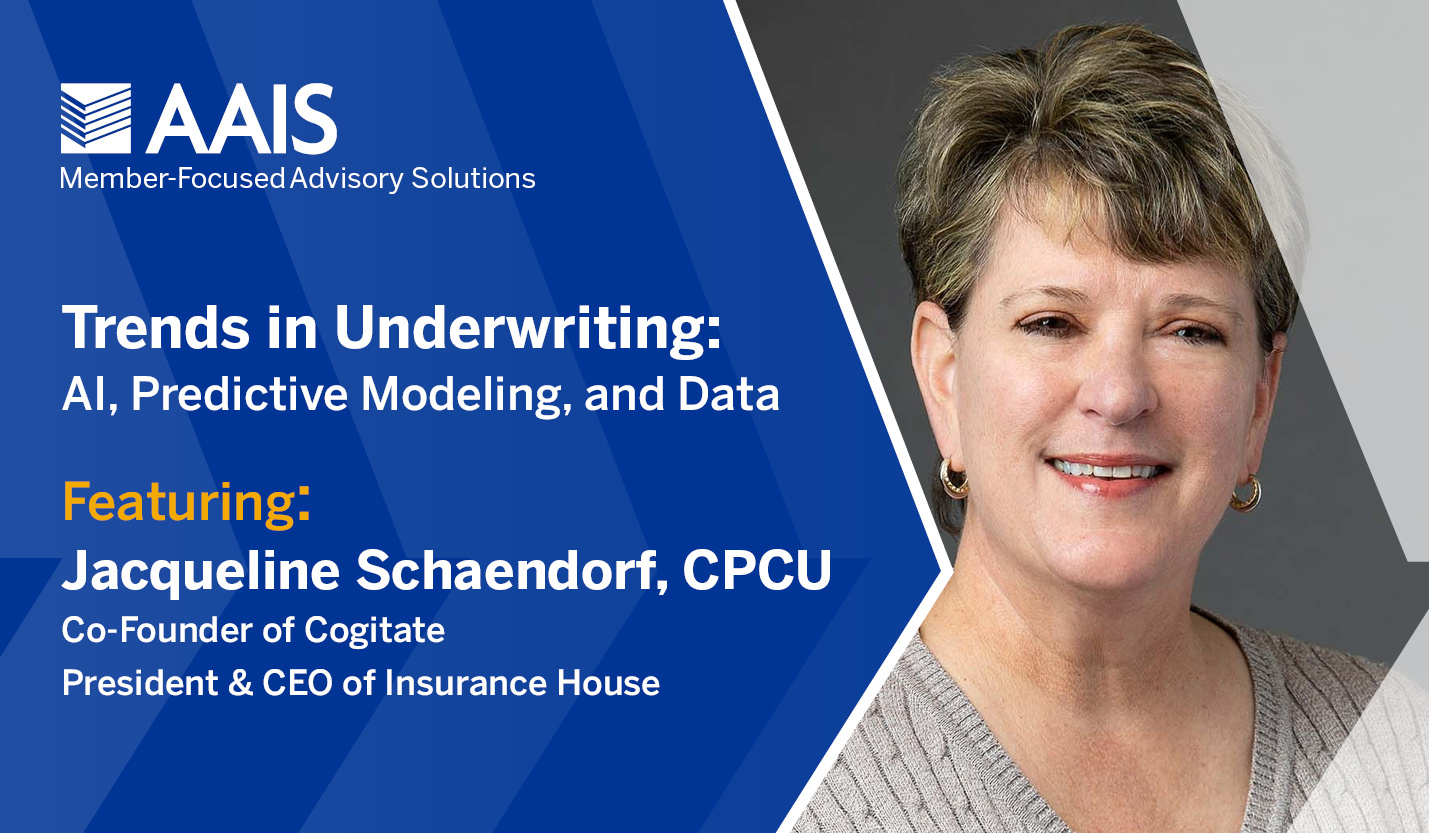Artificial intelligence (AI) is revolutionizing the underwriting process, offering unprecedented opportunities for efficiency and accuracy in the insurance industry. In this interview with AAIS Partner, Cogitate, we explored how AI is promising a new era in data interpretation and utilization. Jacqueline Schaendorf, CPCU, Co-Founder of Cogitate and President and CEO of Insurance House, discussed the potential of predictive modeling in underwriting and claims processes, significant data challenges faced by carriers, and innovative solutions offered by Cogitate.
AI (2)
AI, Predictive Modeling, and Data Trends in Underwriting
Jul 18, 2024 / by AAIS posted in Issues & Trends, Data & Technology, Data, Modeling/Predictive Analytics, Data/Tech, Underwriting, AI, Artificial Intelligence, Cogitate
AI Home Inspections: Enhance Loss Prevention and Reinsurance
Jul 10, 2024 / by AAIS posted in Personal Lines, Technology, Data & Technology, Homeowners, Data/Tech, AI, Artificial Intelligence, CHRP Technologies
The connection between home inspections and securing reinsurance is crucial for insurance carriers. In this interview with AAIS Partner, Chrp Technologies, we delve into the pivotal role of maintaining a high-quality book of business for insurers seeking reinsurance. Micah Kalisch, Founder and CEO of Chrp Technologies, elucidates how adhering to inspection protocols aligned with stringent underwriting standards not only safeguards insurers against potential risks, but also enhances their appeal to reinsurers. He also discusses how Chrp can support underwriters throughout this process.
Applications of GenAI in Insurance
Jun 19, 2024 / by AAIS posted in Technology, Machine Learning/AI, Data & Technology, Data/Tech, AI, Artificial Intelligence, BluePond.AI, GenAI
Generative Artificial Intelligence (GenAI) is revolutionizing industries with its ability to understand, synthesize, and create language-based content. In this interview with AAIS Partner, BluePond.AI, we explored how this leap forward is particularly impactful in the insurance sector, where manual processes and complex documentation are prevalent. Hear from Pranav Pasricha, CEO of BluePond.AI, to learn what GenAI is, its transformative applications within the insurance industry, the challenges of adopting this technology, and how carriers can effectively navigate these obstacles to harness GenAI's full potential.
Can AI Home Health Assessments Boost Reinsurance Capacity?
Jun 12, 2024 / by Micah Kalisch posted in Personal Lines, Technology, Data & Technology, Homeowners, Data/Tech, AI, Artificial Intelligence, CHRP Technologies
Due to today’s hard market, reinsurers are much more selective about the risks they underwrite. To secure reinsurance coverage, personal lines property carriers must maintain a healthy book of business and loss ratio.
The Art of the Possible with GenAI in Insurance
May 23, 2024 / by Sachin Kachare posted in Technology, Data & Technology, P&C Insurers, Data/Tech, Underwriting, AI, Artificial Intelligence, Brokers, Insurance Agents, MGA, BluePond.AI
Today, there is a lot of buzz surrounding generative artificial intelligence (GenAI) and its potentially significant implications for the insurance industry. The use of GenAI in insurance is taking a large step forward, leading the paradigm shift in AI and machine learning (ML) due to its efficient and innovative features. In the dynamic realm of insurance, burdened by cumbersome manual processes, traditional AI solutions are limited. GenAI transcends these limitations, offering transformative solutions to streamline insurance workflows and propel the industry forward.
Applying AI to Solve the Talent Crunch and How to Avoid Its Pitfalls with WAHVE CEO
Mar 13, 2024 / by AAIS posted in Machine Learning/AI, Remote Work, WAHVE, AI, Artificial Intelligence, talent gap, Advisory Report
For this Advisory Report, AAIS spoke with Sharon Emek, Ph.D., CIC, CEO of AAIS Partner, WAHVE, a unique contract staffing talent solution serving the insurance industry, for a two-part series on how to solve the talent crunch and retain quality talent in the insurance industry. In part one, Emek addressed the state of the talent gap in the insurance industry, searching for candidates with AI, advice for hiring managers, and more.






